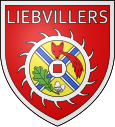Liebvillers
| Liebvillers | ||
|---|---|---|

|
|
|
| region | Bourgogne-Franche-Comté | |
| Department | Doubs | |
| Arrondissement | Montbeliard | |
| Canton | Maîche | |
| Community association | Pays de Maîche | |
| Coordinates | 47 ° 20 ' N , 6 ° 47' E | |
| height | 356-650 m | |
| surface | 3.03 km 2 | |
| Residents | 164 (January 1, 2017) | |
| Population density | 54 inhabitants / km 2 | |
| Post Code | 25190 | |
| INSEE code | 25335 | |
| Website | liebvillers.free.fr | |
 Mairie Liebvillers |
||
Liebvillers is a French municipality with 164 inhabitants (as of January 1 2017) in Doubs in the region Bourgogne Franche-Comté .
geography
Liebvillers is located at 501 m , three kilometers northwest of Saint-Hippolyte and about 19 kilometers south of the city of Montbéliard (as the crow flies). The village extends in the Jura , in a hollow open to the south to the Doubstal , which is deepened into the high plateau of Lomont .
The area of the 3.03 km² municipal area covers a section of the French Jura. The main part of the area is taken up by the Liebvillers Mulde, which is around 1.5 km long and a maximum of one kilometer wide at the top of the valley slopes. The area is drained by the Dorfbach south to the Doubs. In the west, north and east the hollow is flanked by steep slopes, which are crowned at the upper edge by the rocks of a resistant limestone layer. The municipal boundary mostly runs above the steep slope. In the west, the Fontenotte promontory also belongs to the municipality. Another limestone layer protruding from the landscape marks the terrain in the south, which leads to the Doubstal valley, which is more than 100 m below. The Doubs flows here through a narrow valley from east to west and has formed a flat valley floor that is no more than 300 m wide. The southern border runs along the river.
The Nadam settlement ( 369 m ) in the Doubstal and various individual farms belong to Liebvillers . Neighboring communities of Liebvillers are Montécheroux in the north, Saint-Hippolyte in the east, Bief in the south and Noirefontaine in the west.
history
In the caves of the limestone cliffs above the village, traces of human presence in the Paleolithic were discovered. Liebvillers is first mentioned in writing in 1136 under the name Libunwiller in a deed of ownership from the Lucelle monastery . The names Libunvillar and Lebonvillar (1139), Libovilare (1179), Liboviler (1187), Libunvilar (1234), Liebvillers (first 1242), Liebvillaire (1702) and Liebevillers (1765) appeared later . In 1242 Liebvillers sold the Lucelle monastery to the lords of Neuchâtel. From then on the village belonged to the Clémont rule. This rule had been under the sovereignty of the Principality of Württemberg-Mömpelgard (Montbéliard) since 1506 , shared its fate and finally came under French administration in 1748. Liebvillers was badly affected during the Thirty Years' War . In the 19th century, the water power of the Doubs was used to operate blacksmiths. With the opening of the railway line from Montbéliard to Saint-Hippolyte in 1886 (finally closed in 1969), the Nadam industrial estate was connected to the railway network. Since 1931 there has been a hydroelectric power station on the municipality of the Doubstal, owned by Electricité de France , which is fed with water from the weir at Gros Bois (municipality of Soulce-Cernay ).
Attractions

Landmarks of the village, which does not have its own church, are an oak of freedom and a natural bridge (Pont naturel du Bisontin).
population
| Population development | |
|---|---|
| year | Residents |
| 1962 | 331 |
| 1968 | 291 |
| 1975 | 194 |
| 1982 | 162 |
| 1990 | 192 |
| 1999 | 187 |
| 2004 | 209 |
| 2016 | 170 |
With 164 inhabitants (as of January 1, 2017) Liebvillers is one of the small communities in the Doubs department. After the population had declined markedly in the first half of the 20th century (673 people were still counted in 1926), slight population growth has been recorded again since the beginning of the 1980s.
Economy and Infrastructure
Until well into the 20th century, Liebvillers was primarily a village characterized by agriculture (cattle and dairy farming, some arable and fruit growing). Industry that was dependent on hydropower was established early on along the Doubs . Today there are only a few local small businesses left. Many workers are therefore commuters who work in the larger towns in the area.
The municipality is located off the main thoroughfares, but is easily accessible from the D437 departmental road, which leads from Montbéliard through the Doube valley to Maîche . Further road connections exist with Montécheroux and Noirefontaine.
literature
- Le Patrimoine des Communes du Doubs. Volume 2, Flohic Editions, Paris 2001, ISBN 2-84234-087-6 , pp. 1249-1251.
